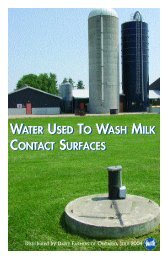Canadian Quality Milk On-Farm Food Safety Program - Centre ...
Canadian Quality Milk On-Farm Food Safety Program - Centre ...
Canadian Quality Milk On-Farm Food Safety Program - Centre ...
Create successful ePaper yourself
Turn your PDF publications into a flip-book with our unique Google optimized e-Paper software.
<strong>Canadian</strong> <strong>Quality</strong> <strong>Milk</strong><br />
Retest 1−3 weeks after the first test to confirm acceptable results.<br />
Test before using a well that has not been in use.<br />
Sample well for pH, iron content, bicarbonates etc. annually.<br />
7.4.3 Interpreting Results of Water <strong>Quality</strong> Analysis<br />
The results of the water analysis can be reported in different ways, depending on the<br />
laboratory. Be careful when comparing the results of analyses from individual<br />
laboratories to published ‘normal’ reference ranges, because the same methods may<br />
not have been used in the laboratory that determined the reference ranges.<br />
Contact the laboratory that performed the testing on your water or your local authorities<br />
for the appropriate normal reference range.<br />
7.4.4 Corrective Action When Water is Contaminated<br />
When water samples fail to meet water quality objectives, the appropriate remedial<br />
action depends on the type and extent of the contamination. This usually requires a<br />
consultation with specialists in water supply and water treatment. The large water<br />
demands on most dairy farms usually mean that corrective measures suitable for<br />
domestic use are not practical for farms.<br />
To prepare for an emergency situation, you must have a written corrective action plan<br />
on how to communicate and address the situation where the water sample is<br />
contaminated. The workbook contains a sample form (Record 16). See Chapter 9 for<br />
more information.<br />
You also must record whenever a problem occurs regarding water quality and what<br />
corrective actions were taken to remedy the situation. A sample form is in the<br />
Workbook.<br />
7.5 SUMMARY OF HAZARDS AND BEST<br />
MANAGEMENT PRACTICES<br />
HAZARD SOURCE BEST MANAGEMENT PRACTICES<br />
Bacteria on milk contact<br />
surfaces (including bulk<br />
tank)<br />
BIOLOGICAL<br />
• Build-up of fat, protein<br />
or minerals on milking<br />
equipment and bulk<br />
tank interior<br />
• Improperly cleaned<br />
equipment (milking<br />
units, pipelines,<br />
receiving jar, tank)<br />
Regularly inspect all milk contact surfaces.<br />
Test water supply for provincial<br />
microbiological parameters annually.<br />
Establish a Standard Operating Procedure<br />
(SOP) for post milking system cleaning.<br />
Use approved cleaning products according to<br />
the accessible milk house wash charts.<br />
7—14<br />
June 2010
















